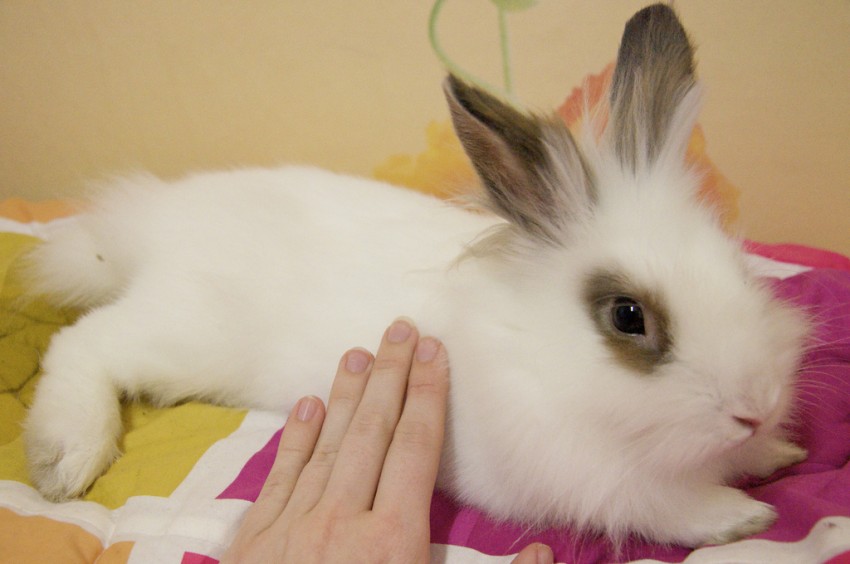
Rabbits are similar to guinea pigs in many ways, but caring for a pet rabbit is different.
Pet rabbits live an average of 8–13 years.
There are various breeds and varieties of rabbits — this expert guide to caring for pet rabbits can help you determine if one is the perfect pet for you.
Part 1: Background on Rabbits
Pet rabbits can live indoors or outdoors. The life expectancy of a rabbit is between 5 and 25 years:
- Indoor rabbits generally live 8–13 years, although many people claim that a good diet will significantly extend a rabbit’s life.
- Outdoor rabbits live 5–7 years as they are generally not as well socialized, fed or protected from the climate.
They are descendants of the wild European rabbit, whose scientific name means “hare-like digger of underground passages.”
Rabbits are herbivores and are most active at dawn and dusk. They remain underground during most of the day to avoid predators in the wild.
They have several protective features that are noticeable even when they are kept as pets:
- Large ears help them hear well.
- Great sense of smell is their main method of communication.
- Muscular hind legs allow rabbits to run up to 50 mph and thump them as a warning signal to other rabbits.
- Rabbits can quietly communicate with one another through low vocalizations.
- Teeth continuously grow and must be maintained through consuming grass and hay.
- A single female can produce 30 or more offspring in a single season and become pregnant again within hours of delivery.
- Rabbits respond well to reward-based training and can be house-trained.
- Gross fact: Rabbits are similar to guinea pigs in that they excrete 2 types of droppings: hard droppings that are waste, and soft droppings that are consumed again by the rabbit as part of their dietary needs.
Part 2: Pet Rabbit Habitat
First, let’s go over some basic points about building a great pet rabbit habitat:
- Rabbits need room to run, jump, dig and stand full upright.
- They also need a hiding place to retreat to when they’re scared.
- Consistent temperatures and good ventilation is essential, and you’ll need to regularly maintain clean areas for bedding and waste.
- Clean the habitat at least once per week, and replace fresh food and water daily.
- Rabbits are curious creatures, so be sure to have safe toys to entertain them (boredom or stress can increase illness vulnerability), and keep harmful objections out of reach.
- They need enough bedding to keep warm and this is especially important if your rabbit is housed outdoors.
Preparing the Habitat for Your Pet Rabbit
You should have a hutch that is at least 4 feet long, 2 feet wide and 2 feet deep so your rabbit has plenty of room to move around. If you get a pair of rabbits, you’ll need more room.
If the hutch is made of wire, make sure there are plenty of areas where your pet can rest their feet.
If the rabbit hutch is outside, you may have to make weather provisions depending on your climate — or consider bringing the rabbit inside when outdoor conditions are not favorable.
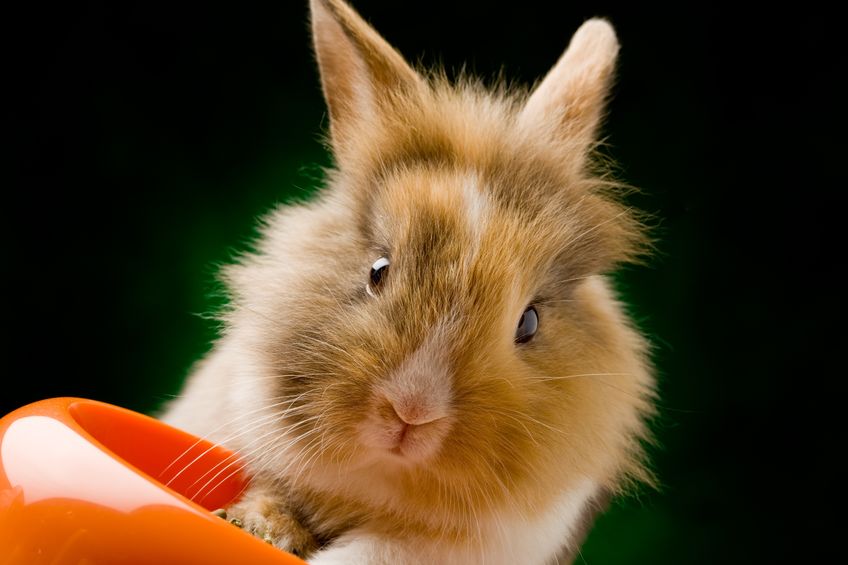
Part 3: Pet Rabbit Diet
Rabbits make fantastic house pets, but many people don’t know much about their diets.
If you are used to dogs and cats, you go to the pet food aisle and buy dog and cat food. So if you introduce a bunny into your fur family, you go buy rabbit food, right? Wrong.
Pelleted rabbit diets should constitute only a tiny portion of a healthy rabbit diet. Many purists feed no pellets at all.
Rabbits are miniature herbivores. They need hay, hay and more hay. Add to that some great veggies, and your rabbit is off and thumping.
Obesity is a big problem in the pet rabbit population. Bunnies continue to gain popularity as pets — and their humans continue to feed too many treats and offer too little exercise.
Dangers of Obesity
Just like humans, dogs and cats, overweight rabbits run a higher risk of developing heart disease, diabetes, liver disease and high blood pressure.
They become arthritic more easily, have stressed joints, and develop ulcers and foot infections (pododermatitis) related to their obesity.
- Fat inside the abdomen can alter proper digestion, adding to gut stasis.
- Fat on the body can prevent a bunny from turning around and eating those all-important cecotropes and from keeping their private areas clean. This leads to urine scalding, as well as caked-on feces on the outside and poor digestive health on the inside.
Veterinarians often don’t see these obese bunnies until they are brought in for some procedure that requires anesthesia.
Obese rabbits are a high anesthetic risk. Because it takes many months to get an obese rabbit to safely lose weight, a necessary surgical procedure may have to wait or be done with added risk.

Diet, along with exercise (which we’ll discuss in a bit), is all-important in keeping your rabbit fit and trim.
It’s so easy to love these little furballs, so much of that affection translates into over-feeding. Also good to keep in mind: Rabbits are intelligent and good at begging.
Here are some guidelines on feeding your pet rabbit to keep your pet healthy:
Hay
Grass hay, such as timothy, oat, brome and wheat, should be available to your rabbit at all times.
If you are lucky enough to get fresh hay, go for it. Good companies like Oxbow and American Pet Diner also sell high-quality hay for rabbits.
Mix your grass hays to make sure your rabbit is getting all the nutrients. Grass hays are a great well-balanced source of Vitamins A and D, as well as calcium and protein. Eating hay promotes healthy teeth and gut. The rabbit GI tract is prone to problems in motility and impaction if not fed a good deal of hay.
Alfalfa hay is too high in protein and calcium as a main source of hay. Alfalfa is not a grass but a legume, like peas and beans, which should also be avoided.
Vegetables
If you want to feed a pet a natural vegetarian diet, get a rabbit!
The average 4- to 6-pound rabbit should get somewhere in the neighborhood of 3 to 4 cups of leafy greens and fresh veggies a day.
The House Rabbit Society is one of the best sources for rabbit info on the net. We are listing their very thorough list of veggies and fruits here.
Leafy Greens
This is the most important category of fresh food, comprising about 75% of the fresh diet for a pet rabbit.
- Parsley
- Spinach
- Mustard greens
- Beet greens
- Swiss chard
- Radish tops
- Sprouts
Leafy Greens II (low in oxalic acid)
- Arugula
- Carrot tops
- Endive
- Escarole
- Frisee lettuce
- Kale
- Red or green lettuce
- Romaine
- Turnip greens
- Dandelion greens
- Mint
- Basil
- Watercress
- Wheatgrass
- Chicory
- Raspberry leaves
- Cilantro
- Radicchio
- Bok choy
- Fennel
- Dill leaves
- Yu choy
Iceberg lettuce has no nutritional value.
Feed fresh vegetables. A rabbit is even more susceptible to problems from veggies “on the fringe” of freshness than your own family.
Another tip: They love their greens moist, and this gives them additional hydration.
The key to the above list is variety and rotation. Nutrient composition and oxalic acid content is varied in the greens listed above. Feeding 3 types of leafy greens a day, and changing up those greens the following week, gives your rabbit a tasty and healthy variety.
Non-Leafy Vegetables
Use these in moderation. These are foods that we usually have in our fridges, so be careful not to feed too much of them.
Non-leafy veggies should comprise no more than 15% of a pet rabbit’s diet, which is about 1 tablespoon per 2 pounds of bunny weight.
- Carrots
- Broccoli
- Edible flowers like nasturtiums, pansies and hibiscus
- Celery
- Bell peppers
- Chinese pea pods
- Brussel sprouts
- Cabbage
- Summer squash
- Zucchini
Rabbits love the fresh herbs listed. If you can grow fresh parsley and basil, peppermint, cilantro and dill, you will have a happy bunny. If you grow them in pots in your house, don’t keep the pots at bunny height if you expect to have any basil left for your own pesto!
Fresh Fruit
Fresh fruit should be considered a treat for your rabbit, not to exceed 1 teaspoon per 2 pounds of body weight. A 6-pound rabbit gets 3 teaspoons of berries, peaches or apples a day. This isn’t much. Please heed the warning.
Too much fruit can result in weight gain and GI upset because of the sugar and starch content.
- Apple (no stems or seeds)
- Cherries (no pits)
- Pear
- Peach
- Plum
- Kiwi
- Papaya
- Mango
- Berries
- Pineapple
- Banana
- Melon
- Apricot
- Currants
- Nectarine
Pellets
Pellet diets were invented for the commercial rabbit industry.
Your beloved pet rabbit will not enjoy a long and healthy lifespan if fed a pelleted diet exclusively.
Limiting pellets is the best gift you can give your pet rabbit, along with plenty of hay around the clock and appropriate vegetables. Once your bunny is an adult, restrict pellets, feed grass hay and don’t give commercial treats.
Here’s a handy measuring guide for pellet feeding a pet rabbit:
- 2–4 pound rabbit: 1/8–1/4 cup daily as maintenance; less if overweight
- 4–7 pound rabbit: 1/4–1/2 cup daily
- 7–10 pound rabbit: 1/2–3/4 cup daily
A pellet diet, fed on a limited basis, should have at least 22% crude fiber, and contain no dried fruit, seeds, nuts and colored junk that makes you buy it. Many pellet diets are alfalfa based.
The thing is, rabbits do not need pellets at all. Good hay and healthy vegetables are a complete diet if fed appropriately.
Quit the Pet Rabbit Junk Food
We get sick to our stomach when we walk into a big pet store and see the junk food marketed for rabbits and other critters.
Beware of slogans like:
- “Great way to bond with your pet.”
- “Add variety to their diet.”
- “Fun to eat.”
- “Helps overcome cage boredom.”
Do you know what’s in these treats? We’ll tell you:
- Corn syrup
- Corn starch
- Wheat flour
- Molasses
- Sugar
- Vegetable oil
- Dried fruits
Rabbit Rice Pops that come in Christmas colors? Get out of that aisle.
Varied, super-fresh veggies and delicious-smelling hay are all the fun food bunnies need. Instead of processed treats to alleviate cage boredom, we have a more natural suggestion: Let your pet rabbit out of the cage.
Water
Have fresh water in the hutch daily. You can use a tip-proof bowl or a sipper bottle, which you can buy in pet supply stores.
If you get a sipper bottle and your bunny hasn’t used one before, keep an eye out to make sure your pet is using it.
Again, change the water daily.
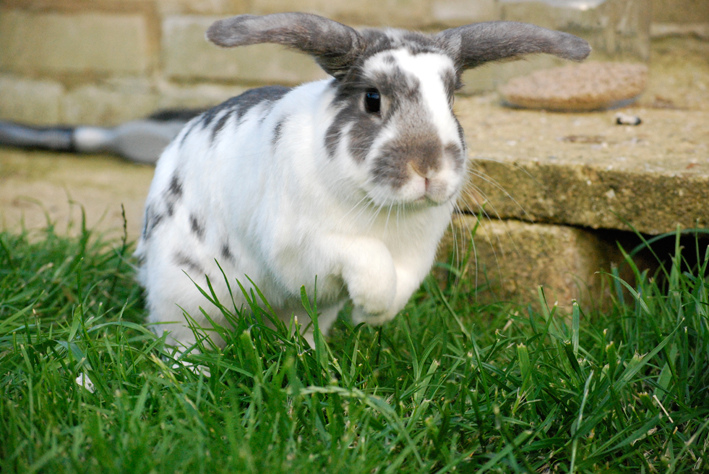
Part 4: Pet Rabbit Exercise
House rabbits need exercise.
Good rabbit people let their bunnies run about, train them to a litter box and bunny-proof the house.
But too many rabbits spend too much time in a cage with no outlet to burn up fat. Those lagomorphs need to do a few laps.
If you can’t rabbit-proof your entire house, your bunny will appreciate any large space to frolic about, as long as they are not confined to their cage all day long.
Ideally, the cage should be big enough to allow a bit of activity too. Outdoor spaces are more difficult to make safe, but we’ve seen people build fantastic outdoor enclosures that keep bunnies active and predators out.
Rabbit Agility and Rabbit Jumping
Now, to be clear, rabbit agility and rabbit jumping are 2 different sports:
- Rabbit agility is similar to dog agility, with equipment sized down for agile bunnies. On or off the leash, rabbits learn to run an agility course with the help of their handlers. This is great interactive fun for rabbits, handlers and spectators.
- Rabbit hopping (rabbit jumping) is popular in Europe. Rabbits are worked on a leash in this sport, where they jump amazing lengths and heights.
Play and Exercise
Rabbits are quite social, and it will be up to you to provide play and entertainment.
Letting your rabbit out of the hutch to roam around and interact with you is important.
You will find that your bunny has favorite spots to be scratched and petted, but most like to have the tops of their heads touched. Petting your rabbit also helps remove loose hair that can form into hairballs when your rabbit self-grooms.
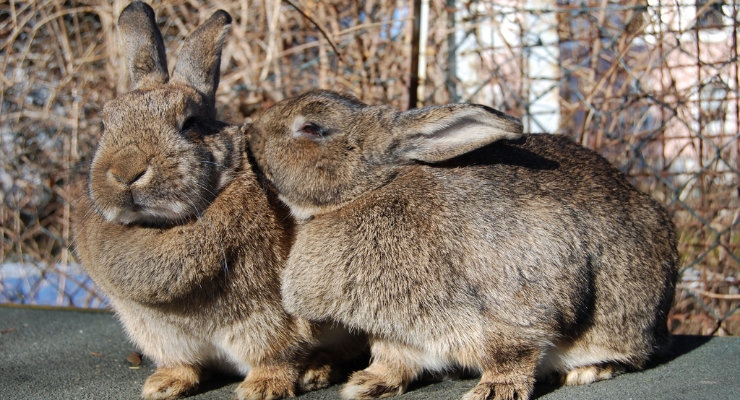
Part 5: How to Bond With Your Pet Rabbit
For those of you interested in getting a pet rabbit, good for you!
Rabbits are fun, smart and beautiful creatures who can add a lot of enjoyment to your life.
The trick is getting started when you’ve never had a rabbit before. An important note: Rabbits tend to be fearful by nature, and for good reason — they are prey for other animals, such as foxes and even cats.
Getting your rabbit to overcome that fear and bond with you can be a bit tricky, so we’ve collected 4 expert tips to help you out:
Cuddle Frequently
In his book Hobby Farms: Rabbits: Small-Scale Rabbit Keeping, rabbit lover Chris McLaughlin stresses how important it is to hold your rabbit often:
“Handle your bunny for short periods every day. It isn’t the length of time that you hold and pet … that’s important; it’s the frequency.”
You want your bunny to associate you with warmth and to know that you are trustworthy. Giving them short cuddles every day will help tremendously as they learn that when you pick them up it means something nice.
As your rabbit gets more comfortable with you, you can extend the cuddle sessions.
Be Calm and Quiet
Loud noises will scare your rabbit, so use a calm, low voice.
Don’t yell or shout — and discourage others from doing so around your rabbit.
According to the Royal Society for the Prevention of Cruelty to Animals, rabbits will “recognize their owners by shape, smell and voice.”
You want your rabbit to associate the sound of your voice with security, not fear.
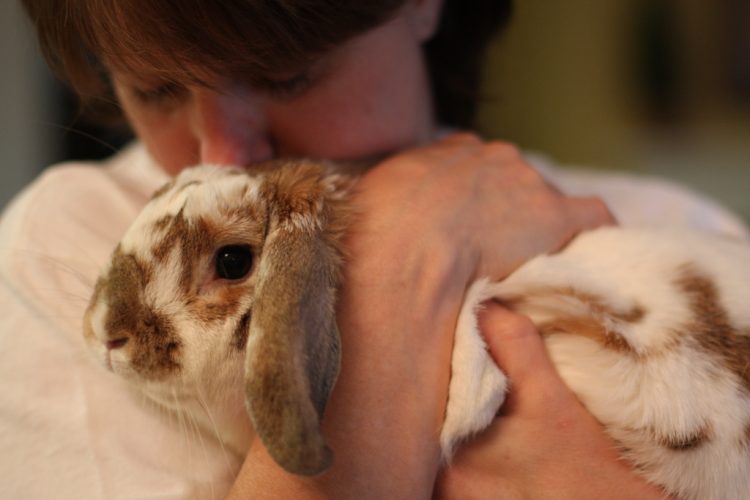
Keep Other Pets Out
Both dogs and cats naturally prey on rabbits in the wild.
This means these pets may see your new rabbit as a food source rather than a companion.
So keep dogs and cats away from your rabbit, if possible. Your bunny should always feel — and, more important, be — secure in their cage when you aren’t around, because you never know when Howie the dog or Buttons the cat might go into stalking mode.
“Besides terrifying your rabbit,” says McLaughlin, “this could also cause serious injuries.”
Watch this baby bunny “binky” — in front of a cat, no less!

Handle Your Rabbit Securely
Rabbits prefer to keep their feet on the ground so they can run at a moment’s notice.
Handle yours properly so they feel as secure in your arms as possible. Otherwise, they may kick or squirm, causing unintentional injury.
“The best way to practice lifting and carrying your rabbit is by using a large, flat table that’s about waist high,” McLaughlin explains.
“To pick up a rabbit, put one hand under him, just behind his front legs. The lower part of its chest will rest in your hand. Put your other hand underneath the rabbit’s rump. The idea is to actually lift him with the hand that is under his front legs and chest while the hand on its rump supports his weight.”
Once you have carefully lifted your rabbit, bring them in close to your chest for a cuddle. Don’t be alarmed if they are afraid at first — that’s what this bonding process is for.
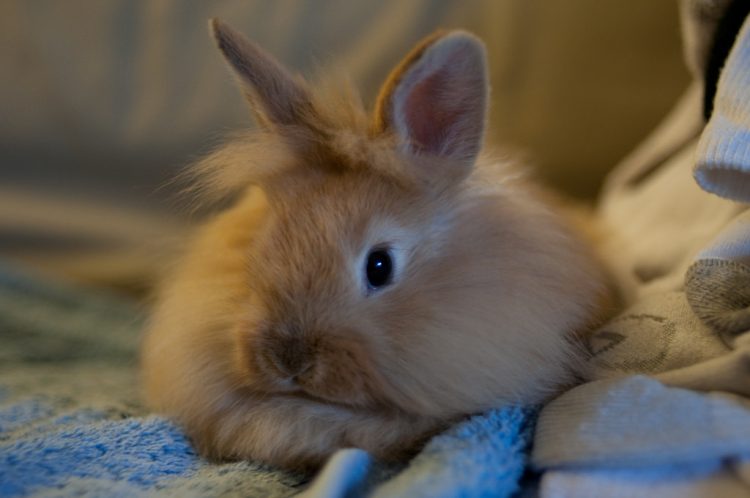
Part 6: How to Keep Your Pet Rabbit Healthy (And Happy)
Rabbits are social creatures and love to have friends around.
In large numbers, rabbits can form a social hierarchy and engage in bullying behavior, so it’s best to keep only a pair together. Adults may fight upon first meeting but can be housed together.
Never leave your rabbit alone with any other animal. Rabbits can become friends with cats and dogs if introduced early and often enough, but leaving them together unsupervised is never a good idea.
As with all animals, a rabbit’s temperament depends on their personality — no breeds are “friendlier” than others.
Rabbits are by nature a prey animal, meaning they are dinner for a number of carnivores in the animal kingdom. Consider this when playing with them. Just because they are sitting still doesn’t mean they are comfortable.
That said, lots of rabbits are friendly and welcome human attention. They just want it on their level. Try putting a pillow on the floor and lying down while watching television or reading a book — your rabbit will most likely come up to you and enjoy a cuddle.
Keeping Your Rabbit Healthy
Regularly cleaning the habitat, providing clean food and water and monitoring your rabbit’s behavior will ensure you provide the best care possible.
A few other quick health tips:
- Rabbits require vaccinations to help prevent other diseases — keep your pet rabbit’s vaccine current. Make sure your veterinarian is experienced with rabbits or find another professional that is familiar with exotic pets.
- Check the droppings regularly for evidence of flies. Flies can lay eggs and cause a fatal condition called flystrike.
- Clip your pet rabbit’s nails as needed and always have grass and/or hay available to maintain teeth growth.
- Some plants are poisonous to rabbits, so never add anything foreign into the cage.
- Be sure to pay attention to their eating and drinking habits — changes can indicate illness.
- Runny nose? Could be serious, so get to the vet. Here’s why: “A Sad Case of Serious Snuffles in a Rabbit.”
- You can get your rabbit microchipped for identification, and some pet insurance policies cover rabbits.
Why Sunlight Is Important for Pet Rabbits
Indoor rabbits are at risk of Vitamin D deficiency — and a lack of Vitamin D means inadequate blood levels of calcium, which often leads to health problems in pet rabbits.
For more on this, see our companion article “Vitamin D Deficiency in Rabbits: What You Need to Know.”
Neutering
Spaying or neutering your pet rabbit is recommended. This helps reduce aggression in both males and females.
A neutered male and spayed female are suggested as a good pairing.
Ideal Living Conditions
Surprisingly, those with a small apartment should not assume that they need to adopt the smallest bunny possible.
According to the House Rabbit Society:
“There is no apartment too small for even the largest rabbit. And if there were a safe generalization to make, it would be that larger rabbits tend to be less active and therefore require less space than the dwarf breeds.”
Rabbits prefer to live in pairs or groups. This is not necessary if you are home regularly and can provide companionship.
They need their litter boxes changed every 2–3 days, and all rabbit families must bunny-proof their houses, making sure to remove toxic plants and cover all electrical cords.
Rabbit-Proof Your Home
Because rabbits love to chew, make sure that any areas of access are free from electrical cords, cleaning products and any other chemicals that your bunny could have access to by chewing through a container.
Put chewable items in the hutch and other areas accessed so that the rabbit can chew. This is essential for reducing the length of your rabbit’s teeth. More on this below…

The Risk of Dental Disease in Rabbits
If your pet rabbit had a toothache, how would you know?
There’s an old saying, “No hoof, no horse” — meaning the hooves are crucial to a horse’s welfare. However, you could equally argue, “No tooth, no rabbit” because of the importance of a rabbit’s teeth for good health.
What’s the image cartoonists most pick out when they draw a rabbit? Those long front teeth.
These are the “incisors” and are used for cutting, snipping and stripping. In fact, if your rabbit has pulled wallpaper from the walls or destroyed your sofa, they used their incisors to do it.
Once the rabbit has snipped off that tasty dandelion, they use their tongue to thrust it back to their cheek teeth. These are the grinding teeth that break the harsh fiber down into short sections that can be swallowed.
Obviously this is hard work for the teeth, and constant chewing on fibrous grass or hay wears the teeth down. But happily, the teeth love a challenge and just grow a bit faster.
However, the opposite is not true — if the rabbit eats a low-fiber diet and wears the crowns down less quickly, those stubborn old teeth just keep on growing.
Signs of Overgrown Teeth in a Pet Rabbit
Overgrown teeth in a pet rabbit can cause problems.
For one thing, teeth grow in both directions — up into the mouth and down into the jawbone — like a tree putting down roots. A bizarre quirk of biomechanics means that if the crown isn’t worn down, then the roots dig deeper.
This leads to pain, discomfort when chewing and tooth root abscesses.
So, what other signs might your rabbit show?
- A wet chin: The “slobbers” comes about because their mouth is too sore to swallow.
- A creamy eye discharge: Those elongating tooth roots in the skull press on the tear ducts and prevent tear draining. This then becomes infected and leads to a creamy-white eye discharge.
- Matted fur: If the mouth is too sore to groom, the coat soon begins to suffer.
- Caecotrophs stuck to his bottom: Caecotrophs are the large moist pellets a rabbit produces that they re-eat. When their mouth hurts, they’re more reluctant to re-eat this vital source of nutrition, and the pellets get stuck in their fur.
- Facial abscess: A tooth root infection can erupt as a pocket of pus on the face.
- Weight loss: When it hurts to chew, the rabbit isn’t going to eat as much as they need.
This video shows how to check your rabbit’s cheek teeth and incisors at home:

Pelleted Food Is a Problem
As we mentioned earlier, the ideal food for rabbits is grass. It’s what their ancestors ate, and it’s what they’re designed to eat.
- Did you know a rabbit needs to chew for 20 hours a day to thrive on grass? That’s a lot of tooth wear and tear.
- A rabbit on pelleted food can eat a day’s worth of nutrition in just 20 minutes (which leaves those teeth growing).
How long a rabbit spends eating is what makes the difference between a healthy mouth and a toothache. Although it’s true that there are some genetic causes of overgrown teeth, the biggest culprit is feeding pelleted food.
As with so many things, prevention is better than cure. Grass is key, but if you don’t have access, then feed your rabbit high-quality hay.
Teeth Trimming
Do you think your rabbit has tooth problems? Visit a veterinarian comfortable with treating rabbits.
If the incisors are overgrown, there are 2 schools of thought about how to trim the teeth back:
- Scissor clippers: Trimming back the incisors with sharp clippers is common, but there’s a growing argument against it. This is because overgrown teeth are often brittle, which means the tooth may shatter when clipped.
- Burring: This involves a high-speed dental burr, which whizzes away the enamel to keep a clean cutting line. A skilled clinician can do this with the rabbit conscious, and it’s a lot less likely to cause complications.

Part 7: How to House-Train Your Pet Rabbit
Rabbits actually have a great deal in common with cats.
They can be social, friendly and affectionate creatures who genuinely enjoy spending time with their people. These virtues mean that rabbits make great indoor pets.
Rabbits are also similar to cats in a rather dismaying way — they’ll spray and mark territory all over your house.
The good news? You can house-train pet rabbits, and then you can let them roam freely. But how do you house-train a rabbit?
Disarm the Spray
First, let’s address the dominance and territorial factors at play in spraying.
Both females and males mark their territory in this way. But, as with cats and dogs, spaying and neutering by a veterinarian helps tremendously with this behavior.

Use a Litter Box
You can house-train your rabbit using a plain old litter box, just as you would for a cat.
In The Rabbit-Raising Problem Solver, author Karen Patry has outlined some simple and effective steps for this training:
- Put either 1 large box or 2 smaller boxes inside the rabbit cage.
- Fill the box(es) with specially chosen litter. Don’t use traditional cat litters — some have potentially toxic crystals. You can use litter made from alfalfa, hay, oat or paper. It may help to line the bottom of the box with newspaper to absorb urine.
- Line the bottom of the rest of the cage with newspaper. When your bunny defecates or urinates on the paper, move it to the litter box to send the message that “this is where it goes.”
- Repeat step 3 once or twice a day, and make any adjustments necessary based on your bunny’s behavior. For example, if they consistently urinate in one spot, move the litter box to that spot.
- When you go a few days with no soiled newspaper outside the litter boxes, your rabbit should be house-trained.
Once your rabbit has mastered the art of using the litter box inside the cage, you can repeat steps 1–4 in a small area outside the cage.
As the rabbit comes to understand the concept of the litter box, you can gradually increase the area in which they are allowed to roam.
Watch this tutorial on making your own tray to keep your rabbit mess-free when they use the litter box:

Keep an Eye Out for the Occasional Mess
Although spaying and neutering helps tremendously, when there is more than one rabbit sharing the same space, they will often continue to mark territory.
In some cases, once all the rabbits are house-trained, they will use the litter box with no issues. In other cases, you may have to be vigilant — and expect a mess once in a while.
If your rabbit suddenly starts to regress, simply start all over again back in the cage.
Monitor Your Rabbit’s Elimination Habits
Some illnesses may affect a rabbit’s consistent use of the toilet you’ve provided.
Common signs of illness include:
- Diarrhea
- Incontinence
- Loss of appetite
- Labored or heavy breathing
- Runny nose
Don’t hesitate to seek veterinary care for your rabbit if you notice any symptoms.
Bunnies are smart, funny and fun pets to have. It’s all the better when you can let them roam about the house and keep you company with little worry about elimination messes. Happy training!

Part 8: Our Final Advice on Pet Rabbits
Playing With Rabbits
Rabbits are social creatures who like human attention, but they don’t play fetch like other animals.
They do, however, rabbit toys are a great way to get your rabbit to exercise and keep them from chewing on your furniture and electrical cords.
Some rabbit families report success at getting their bunnies to walk with leashes so they can be taken outside, but most rabbit care societies discourage this practice. As mentioned, rabbits are prey animals and get stressed when they feel that their means of escape are limited in some way.
Ideal Rabbit Families
Rabbits fit with lots of different people. They can even live with dogs and cats as long as the other animals are well trained.
Households with children must take care that the young ones are shown proper rabbit handling. Some organizations recommend that children be 12 years or older.
Donna of the New York Rabbit Meetup Group gives this advice:
“Anyone who is responsible and caring can be a rabbit owner, but someone who loves to play and dole out food is ideal! Being attentive is key too, since rabbits, being prey animals, instinctively hide any sort of illness, so you really need to pay attention to any sort of unusual behavior and act quickly if anything is wrong.”
How to Rescue a Rabbit
Rabbits are excellent pets for a wide variety of people. Rescue groups are a great source of information for determining if a bunny is right for you.
Petfinder.org has hundreds of available bunnies waiting for a good home. The House Rabbit Society also facilitates adoptions.
References
- Mayer, Joerg, DMV, MSc, DABVP (ECM), DECZM. “Bacterial and Mycotic Diseases of Rabbits.” Merck Veterinary Manual. https://www.merckvetmanual.com/exotic-and-laboratory-animals/rabbits/bacterial-and-mycotic-diseases-of-rabbits.
- American Rabbit Breeders Association, Inc. https://www.arba.net/.
- Krempels, Dana M., PhD. “GastroIntestinal Stasis, The Silent Killer.” H.A.R.E., Inc. June 2005. http://www.bio.miami.edu/hare/ileus.html.
- “What to Feed Your Rabbit.” House Rabbit Society. Jan. 10, 2013. https://rabbit.org/what-to-feed-your-rabbit/.
- McLaughlin, Chris. Hobby Farms: Rabbits: Small-Scale Rabbit Keeping. i5 Publishing. 2012. 23.
- “10 Interesting Facts About Rabbits.” The Royal Society for the Prevention of Cruelty to Animals (RSPCA). https://www.rspcavic.org/health-and-behaviour/rabbits/10-interesting-facts-about-rabbits.
- “Handling.” Rabbit Rehome. http://www.rabbitrehome.org.uk/care/handling.asp.
- Patry, Karen. The Rabbit-Raising Problem Solver. Storey Publishing. 2014. 48.
- Harcourt-Brown, Frances. Textbook of Rabbit Medicine. Butterworth-Heinemann.
 This expert guide to caring for a pet rabbit was written by Dr. Debora Lichtenberg, VMD, with contributions from Dr. Pippa Elliott, BVMS, MRCVS. Writers Kristine Lacoste, Melissa Smith, Sarah Blakemore and Kristen Youngs also contributed to this article.
This expert guide to caring for a pet rabbit was written by Dr. Debora Lichtenberg, VMD, with contributions from Dr. Pippa Elliott, BVMS, MRCVS. Writers Kristine Lacoste, Melissa Smith, Sarah Blakemore and Kristen Youngs also contributed to this article. 

